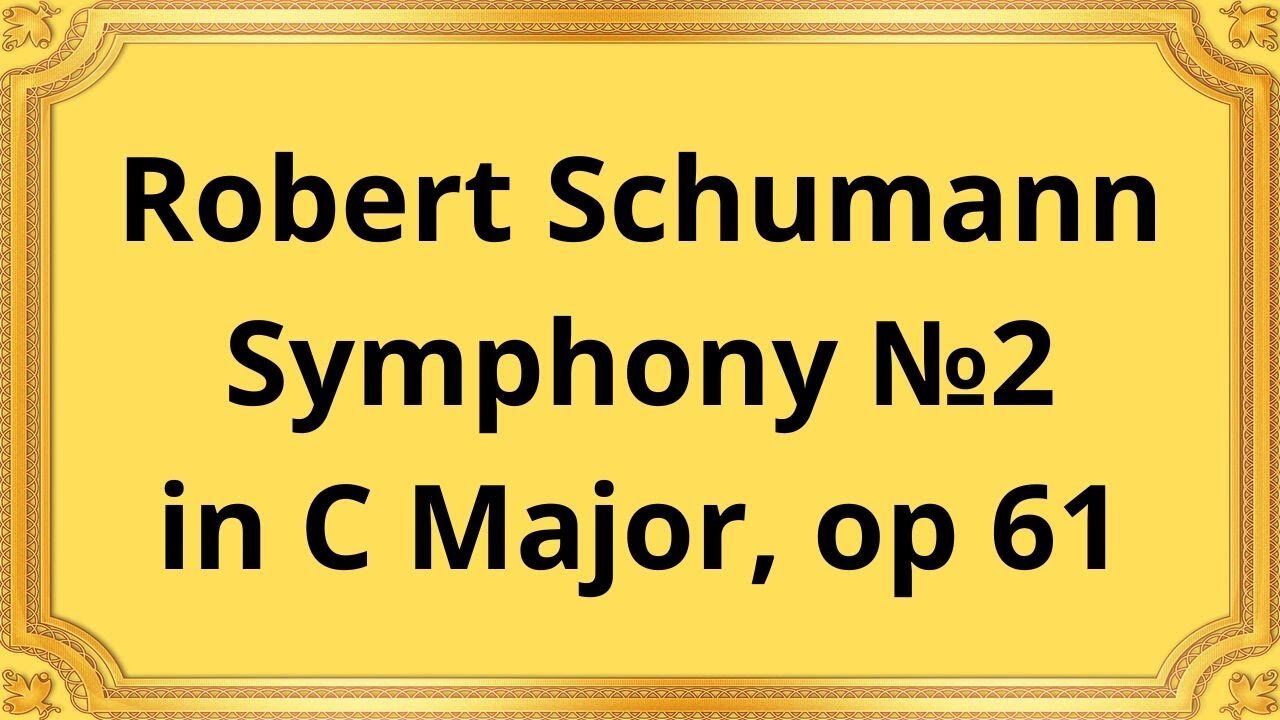Premium Only Content

Robert Schumann Symphony №2 in C Major, op 61
#RobertSchumann #SymphonyNo2 #CMajor #Opus61 #ClassicalMusic #MusicalComposition #RomanticEra #OrchestralMusic #GermanComposer #MusicHistory #Masterpiece #EmotionalDepth #OrchestraPerformance #SymphonicWork #MusicalGenius
Sir Adrian Boult;
The Philharmonic Promenade Orchestra
In the realm of classical music, certain compositions stand out as profound expressions of the human spirit. One such masterpiece is Robert Schumann's Symphony No. 2 in C Major, Op. 61.
Robert Schumann composed his Symphony No. 2 between 1845 and 1846. During this period, Schumann experienced personal and professional challenges, including his struggles with mental health. However, this symphony reflects a sense of triumph and resilience, showcasing Schumann's ability to find solace and inspiration in the face of adversity.
The symphony follows the traditional four-movement structure commonly found in classical symphonies. The first movement, marked "Sostenuto assai - Allegro ma non troppo," opens with a serene and introspective introduction, gradually building up to a vibrant and energetic main theme. It captivates the listener with its dynamic contrasts and intricate orchestration.
The second movement, "Scherzo: Allegro vivace," is a lively and playful interlude, characterized by its rhythmic drive and melodic charm. It provides a delightful contrast to the intensity of the first movement.
The third movement, "Adagio espressivo," is a poignant and lyrical section that showcases Schumann's gift for crafting deeply emotional melodies. It evokes a sense of yearning and introspection, inviting the listener into a world of profound beauty and vulnerability.
The final movement, "Allegro molto vivace," bursts with energy and exuberance. It is a joyful and triumphant finale, brimming with cascading melodies and spirited rhythms. The symphony concludes with a sense of elation, leaving the listener uplifted and inspired.
Schumann's Symphony No. 2 is a testament to the emotional depth and complexity of his musical genius. It encompasses a wide range of emotions, from moments of exuberance and joy to introspection and contemplation. The symphony reflects Schumann's own personal struggles, but also his unwavering belief in the power of music to transcend adversity and inspire the human spirit.
Conclusion:
Robert Schumann's Symphony No. 2 in C Major, Op. 61, stands as a testament to the transformative power of classical music. Its historical context, meticulous musical structure, and emotional depth make it a masterpiece of the Romantic era. As listeners, we are drawn into a journey of joy and struggle, experiencing the highs and lows of the human experience. Schumann's symphony continues to captivate audiences, reminding us of the enduring power of music to touch our souls and ignite our spirits.
You have the opportunity to support the channel:
https://destream.net/live/RadSiarAl/donate
https://www.buymeacoffee.com/6355radsiaral
-
 34:26
34:26
Classical music_Music Inspiration
1 month agoAram Khachaturian Concerto for Violin and Orchestra
802 -
 DVR
DVR
Bannons War Room
10 days agoWarRoom Live
2.62M440 -
 16:06
16:06
The Rubin Report
10 hours agoProof the Islamist Threat in England Can No Longer Be Ignored | Winston Marshall
58K58 -
 2:07:07
2:07:07
Robert Gouveia
7 hours agoFBI Files Coverup! Bondi FURIOUS; SCOTUS Stops Judge; Special Counsel; FBI Does
74.6K62 -
 56:15
56:15
Candace Show Podcast
7 hours agoBREAKING: My FIRST Prison Phone Call With Harvey Weinstein | Candace Ep 153
135K93 -
 LIVE
LIVE
Flyover Conservatives
6 hours agoROBIN D. BULLOCK | Prophetic Warning: 2030 Is Up for Grabs – If We Don’t Act Now, Disaster Awaits! | FOC SHOW
2,010 watching -
 2:13:11
2:13:11
megimu32
3 hours agoON THE SUBJECT: The Epstein List & Disney Channel Original Movies Nostalgia!!
19.9K1 -
 9:06
9:06
Colion Noir
12 hours agoKid With Gun Shoots & Kills 2 Armed Robbers During Home Invasion
38.8K8 -
 54:28
54:28
LFA TV
1 day agoUnjust Man | TRUMPET DAILY 2.27.25 7PM
45.1K5 -
 1:36:39
1:36:39
Redacted News
7 hours agoBOMBSHELL EPSTEIN SH*T SHOW JUST DROPPED ON WASHINGTON, WHAT IS THIS? | Redacted w Clayton Morris
166K284